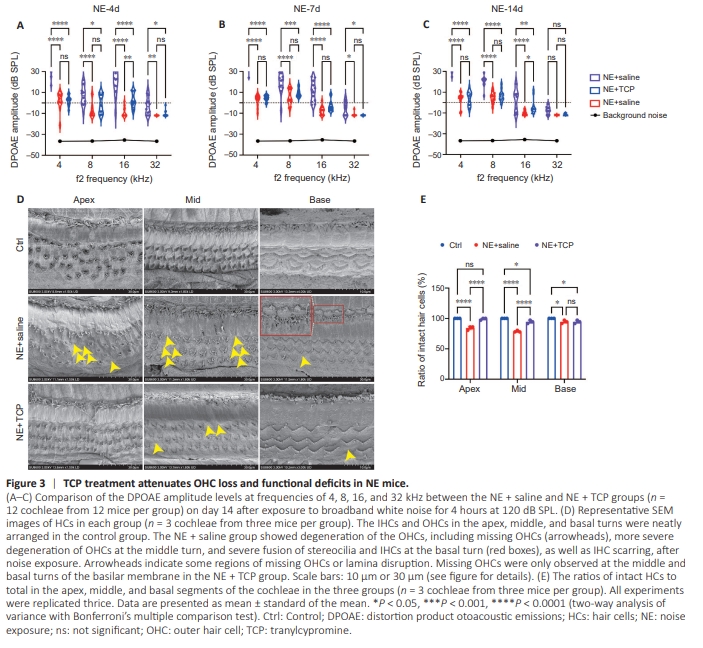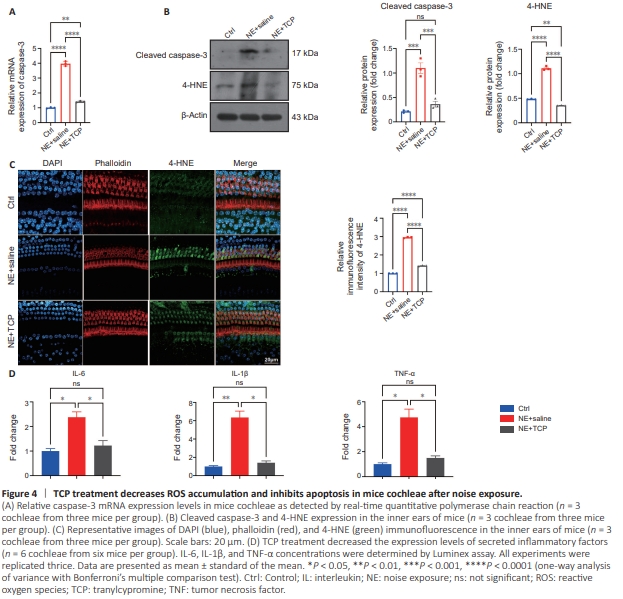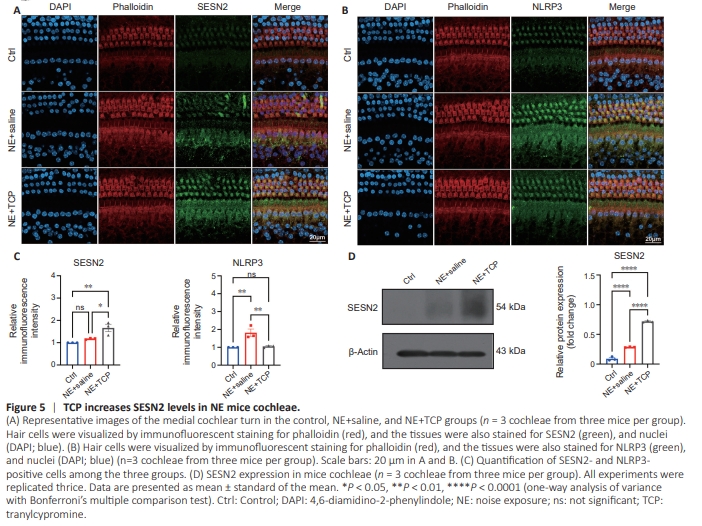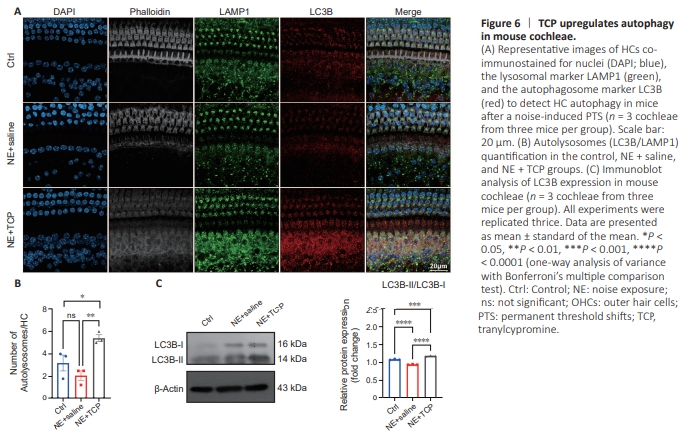周围神经损伤
-
Figure 3 | TCP treatment attenuates OHC loss and functtonal deffcits in NE mice.

DPOAE amplitude analysis showed that TCP treatment attenuated OHC injury at a frequency of 16 kHz (Figure 3A–C). Collecttvely, these results suggest that TCP protected against noise-induced auditory impairment. Next, SEM was performed to observe the HCs in each group in more detail (Figure 3D). In the control group, the IHCs and OHCs at the apex, middle turn, and basal turn were arranged neatly. Compared with the NE + TCP group, the NE + saline group showed degeneration of the OHCs, including missing OHCs, more severe degeneratton of OHCs at the middle turn, and severe fusion of stereocilia and IHCs at the basal turn, as well as IHC scarring, affer noise exposure. The middle turn of the basilar membrane in the NE+saline group showed more severe degeneration and more missing OHCs than the NE + TCP group affer noise exposure. However, missing OHCs were only observed at the middle turn of the basilar membrane in the NE + TCP group (Figure 3E). These results demonstrate that TCP attenuated cochlear HC damage post–noise exposure.
Figure 4 | TCP treatment decreases ROS accumulatton and inhibits apoptosis in mice cochleae affer noise exposure.

To assess intracellular reactive oxygen species (ROS) accumulatton and oxidattve damage following noise exposure, we performed a 4-HNE analysis. Phalloidin and DAPI were used to label HCs and nuclei, respectively, in the mouse cochlea. Immunofluorescence staining demonstrated that 4-HNE expression was higher in the NE+saline group than in the control group (Figure 4B). Moreover, western blot analysis confirmed a notable increase in 4-HNE protein expression level in the NE+saline group compared with that in the control group (Figure 4C). However, TCP treatment effecttvely mittgated the increase in 4-HNE levels in HCs induced by noise exposure. Following noise exposure, ROS levels increase, which in turn activates various apoptotic pathways (Xu et al., 2023). To further validate the effect of TCP on HC apoptosis post– noise exposure, we evaluated cleaved caspase-3 levels. qRTPCR and immunoblot analysis showed a significant increase in caspase-3 expression in the NE + saline group compared with that in the undamaged control group (Figure 4A and B). Furthermore, TCP treatment notably decreased the noiseinduced increase in cleaved caspase-3 expression in mouse cochleae (Figure 4B). Collecttvely, these ffndings demonstrated that TCP attenuated noise-induced oxidative damage and HC apoptosis in the cochlea. Additionally, Luminex assay demonstrated a signiffcant decrease in TNF-α, IL-1β, and IL-6 expression in the NE + TCP group compared with the ffndings in the NE+saline group (Figure 4D).
Figure 5 | TCP increases SESN2 levels in NE mice cochleae.

Next, we assessed alterations in SESN2 protein expression in the cochleae of mice following noise exposure. Immunofluorescence analyses were performed to analyze SESN2 and NLRP3 expression in the cochleae of mice with NIHL (Figure 5A–C). Altogether, our findings demonstrated that TCP treatment increased SESN2 expression in the cochleae of mice subjected to noise trauma (Figure 5D).
Figure 6 | TCP upregulates autophagy in mouse cochleae.

To determine whether there was an association between autophagy and the changes observed in PTS after noise exposure, we assessed LC3B and LAMP1 localization in the mouse cochlea by immunofluorescence. We observed a significant decrease in the number of autolysosomes (LC3B/ LAMP1 autophagic lysosomal complexes) in the NE + saline group and an increase in the NE + TCP group, suggesting that noise exposure inhibited autophagy and TCP triggered autophagy (Figure 6A and B). LC3B protein expression was notably higher in the NE + TCP group compared with that in the NE + saline group (Figure 6C). Collecttvely, these ffndings demonstrated that TCP treatment activated the autophagy pathway, attenuated noise-induced hair cell death, and protected hearing function, indicating that the protective mechanism is localized to the cochlea.